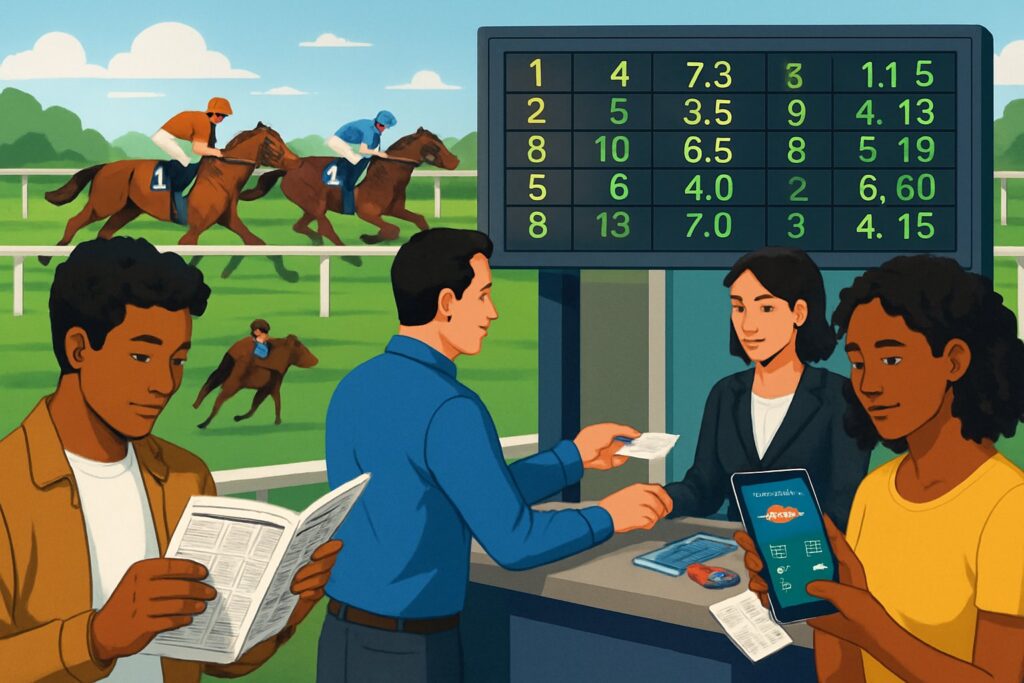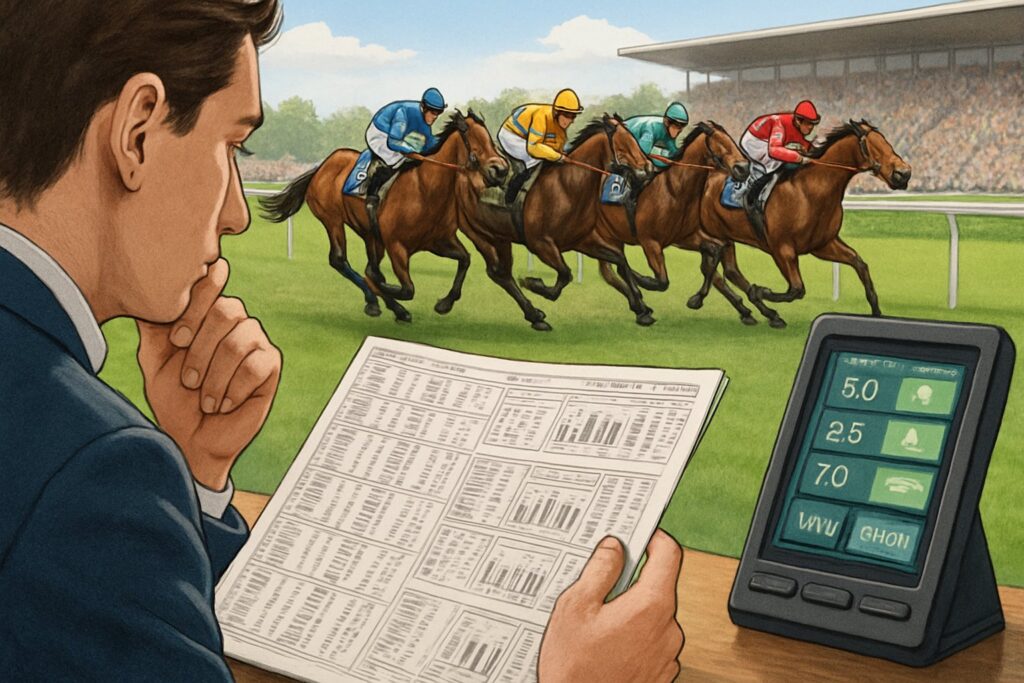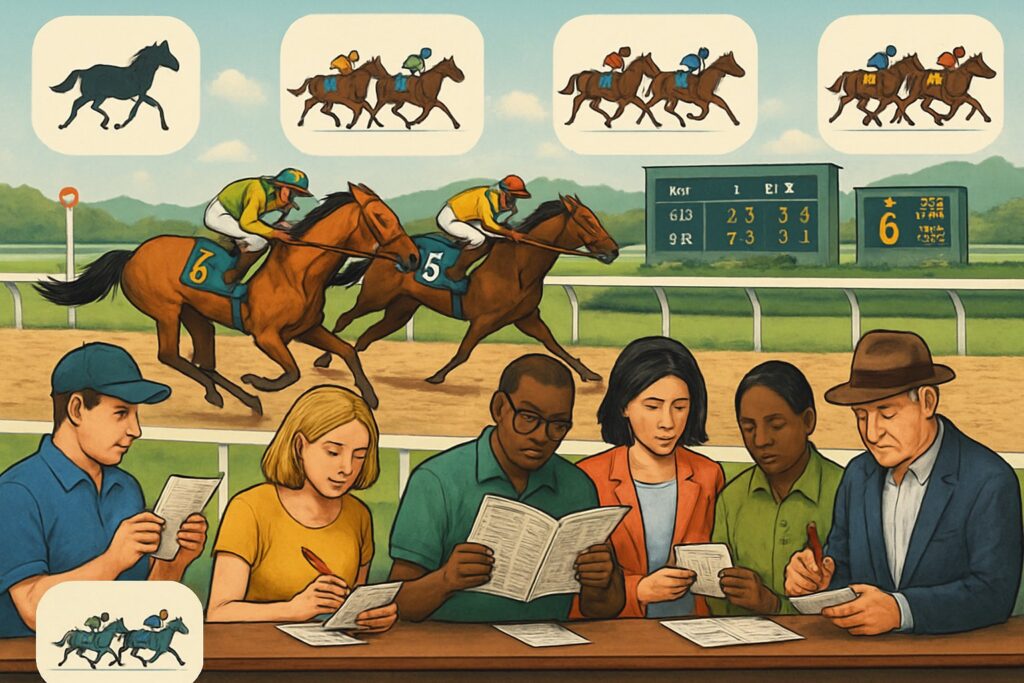by Martin Green
August 9, 2025
Last Updated on August 9, 2025 by Martin Green
Betting on horse racing gets easier once you know the basics. You pick a race, choose your bet type, decide how much to wager, and select the horse or horses you think will do best. From simple bets like “win,” “place,” and “show” to more involved wagers like exactas or trifectas, you get to decide how much risk you want to take on.

You can place bets at the racetrack, through betting terminals, or on online platforms that stream races live. If you check the odds, look at the horses’ past performances, and consider the jockeys’ records, you’ll make smarter picks. It’s definitely more fun when you feel confident in your choices, and you’re not just guessing.
Whether you’re making your first wager or tweaking your approach, understanding each bet and learning how to read a race will give you a leg up. With a bit of prep, horse racing becomes less of a shot in the dark and more of a game of skill.

When you bet on horse racing, you’re predicting the outcome of a race and putting your money on the line. The type of bet, the odds you take, and your stake all decide how much you stand to win or lose.
Horse race betting just means putting money on how a horse will finish in a race. You can bet on a horse to win (finish first), place (finish first or second), or show (finish in the top three).
There are more advanced bets, too, like the Exacta (pick the first two horses in order) and Trifecta (pick the first three in order). These pay more, but they’re tougher to hit.
You can bet at a racetrack, online, or at licensed betting shops. Each option has its own rules and limits, so check before you put your money down.
Knowing the usual betting terms makes things way easier:
| Term | Meaning |
|---|---|
| Win | Horse must finish first |
| Place | Horse must finish first or second |
| Show | Horse must finish in the top three |
| Exacta | Pick first and second in exact order |
| Trifecta | Pick first, second, and third in exact order |
| SP | Starting Price, the odds at race start |
| Odds-on | Odds less than even money (favorite) |
You might also hear “on the nose”—that just means a straight win bet. Picking up these terms helps you read racecards and talk to bookmakers without getting lost.
Odds show how much you can win for your stake and reflect how likely the bookmaker thinks a horse is to win.
For instance, 5/1 odds mean you win $5 for every $1 you bet, plus your stake back. Odds-on like 1/2 mean you’d need to bet $2 to win $1.
There are two main ways odds get shown:
Lower odds mean the horse is more likely to win, but your payout will be smaller. Higher odds mean less chance, but a bigger win if you’re right.

You can keep it simple with a single horse or try more complicated bets that predict multiple outcomes. Every bet has its own rules, payouts, and level of difficulty, which changes your risk and what you could win.
A Win bet is the simplest. Pick one horse – if it finishes first, you win. This usually pays more than the other basic bets, since you’re betting on just one outcome.
A Place bet gives you a bit more wiggle room. Your horse can finish first or second, and you’ll still get paid. The payout’s lower since it’s easier to win.
A Show bet is the safest. Your horse can finish first, second, or third, and you cash in. Payouts are smaller, but it’s a good way to see some returns if you’re playing it safe.
| Bet Type | Winning Positions | Risk Level | Typical Payout |
|---|---|---|---|
| Win | 1st only | High | Higher |
| Place | 1st or 2nd | Medium | Moderate |
| Show | 1st, 2nd, or 3rd | Low | Lower |
An Each-Way bet is basically two bets – one on your horse to win, and one for it to place. You pay for both. If the horse wins, you get both payouts. If it just places, you get the place payout.
This bet is pretty common in the UK and other places. It’s handy if you think your horse could win, but you want a little backup in case it finishes second or third.
A Place bet alone is simpler and cheaper. You just bet on your horse to finish in the payout spots, which can change depending on how many horses are running.
Exotic bets ask you to predict the finishing order for several horses, either in one race or across a few. These are tough to win, but the payouts can be huge.
A Trifecta means picking the first three finishers in order. A Superfecta bet is the first four in exact order. There’s also the Super High-5, where you pick the first five finishers, all in the right order.
Most tracks let you “box” these bets. A boxed trifecta means your horses can finish in any order in the top three. It’s easier to win, but costs more to play.
Before you bet, check out the race card. It’s the official program listing all the day’s races, plus info on each horse, jockey, trainer, and their past results.
Race cards usually show the race distance, surface (turf or dirt), and the weight each horse carries. You’ll see post positions too, which can matter depending on the track.
If you take a few minutes to study the race card, you can spot trends, compare horses, and make smarter bets. It’s worth the effort if you want to move past just guessing.
You’ll need a secure place to bet, money in your account, and a good handle on the race details before you lock in your wager. If you know how to read race info and pick the right bet type, you’ll avoid silly mistakes and probably have a better time.
Pick a licensed sportsbook or betting site that covers your area. Make sure they offer races from the tracks you care about. Most sites post their schedule of tracks and events.
Look for clear odds, easy navigation, and solid customer support. Some sites have live streaming, replays, and form guides, which can really help.
It’s smart to compare fees, minimum bets, and payout times. A good site pays out fast and uses secure payment options. Always check for a license – you’ll usually find it in the footer.
After you pick a sportsbook, sign up for an account. You’ll need to give your name, address, email, and date of birth. Some sites ask for ID before you can cash out.
Add money using whatever payment method works for you – debit card, bank transfer, or e-wallet. Watch for deposit limits or fees before you hit confirm.
Plenty of sportsbooks offer a deposit bonus for new folks, but those usually have strings attached. Read the fine print so you know how and when you can actually cash out any bonus winnings.
The race card lists all the day’s races at a track. You’ll see race numbers, start times, horse names, jockeys, trainers, and odds. Usually you can filter by track or date to find what you want.
Markets just mean the kinds of bets you can make. The basics are Win (horse must finish first), Place (first or second), and Show (first, second, or third). Advanced markets include Exacta, Trifecta, and Quinella.
Check the race card details before you bet. Make sure you know what odds format they’re using (decimal, fractional, or American) so you don’t get surprised by your payout.
To put in a bet, pick the race, choose your horse, and select the bet type. Enter your stake on the bet slip. It’ll show you what you could win based on the current odds.
Double-check everything before you confirm. Once you hit submit, you usually can’t change your bet.
After the race is over and the results are official, your winnings show up in your account. You can cash out or roll them into another bet. It’s a good idea to keep an eye on your betting history for your own records.
You’ll make better bets if you know how to read race details, check past performance, and factor in the track surface or weather. Paying attention to these things helps you compare horses more accurately and maybe even spot some value where the odds seem off.
A race card gives you the basics: horses, jockeys, trainers, race type, distance, and other details. Make sure you spot the program numbers (that’s what you’ll use for betting), and check the post position to see where each horse will start.
Take a look at the morning line odds for the track’s early take on each horse’s chances. These odds might move around quite a bit before the race, depending on how people are betting.
Check out past performance stats—starts, wins, places, and shows. Don’t overlook speed figures, either; they show how fast a horse ran in recent races, adjusted for track and distance. That’s often more telling than just the win-loss record.
The race card also shows equipment changes (like blinkers on or off) and medication use (think Lasix). These can make a real difference in how a horse runs.
| Key Race Card Info | Why It Matters |
|---|---|
| Program Number | Used for placing bets |
| Post Position | Can affect starting advantage |
| Speed Figure | Compares past race times fairly |
| Equipment/Medication | May change performance |
A good jockey can really tip the scales, especially in tight finishes. Check out each jockey’s win percentage and see how they’ve done at this track. Some riders just seem to have a knack for turf, others for dirt.
The trainer’s record matters too. If a trainer racks up wins at similar distances or under certain conditions, that’s a plus in my book.
For the horse, recent form says a lot. Compare its last few races—look for consistency in finishing position and speed figures. Horses coming back from a long break usually need a race or two to get sharp again.
Don’t forget about race class. When a horse drops in class, it might face easier competition. Stepping up in class is almost always tougher.
Track conditions can change fast when the weather shifts. Surfaces get labels like Fast (FST) for dry dirt, Good (GD) for slightly wet, or Sloppy (SY) if it’s a muddy mess. Turf tracks use terms like Firm, Yielding, or Soft.
Some horses just handle certain surfaces or wet weather better. Check their past performances—have they won on today’s surface and condition?
Pay attention to whether the race is on dirt, turf, or synthetic. Changing surfaces can really mess with a horse’s speed and stamina.
Track bias is a thing, too. Some tracks reward early speed, while others let closers come from behind. Watch a few earlier races and see if you can spot a trend.
If you want to do well betting on horse races online, you need to manage your money, pick the right place to bet, and make the most of sportsbook offers. Even small tweaks in these areas can actually add up over time.
Set aside a fixed amount you’re okay with losing. That’s your bankroll. If you lose it, don’t dip back in—just walk away.
Lots of bettors use a percentage staking plan, betting 1-3% of their bankroll per race. This helps you avoid big losses and keeps you in the game longer.
Keep track of every bet. Jot down the race, horse, stake, odds, and result in a notebook or spreadsheet. You’ll spot patterns and figure out what’s working (or not).
When you hit a losing streak, lower your stakes instead of chasing your losses. It’s not exciting, but it keeps your bankroll from disappearing in a hurry.
Betting sites don’t always offer the same odds for a race. Even a tiny difference can impact your profits after a while.
Before you bet, check at least two or three sportsbooks. Go with the one offering the best odds for your pick. For instance, odds of 5.0 instead of 4.8 on a $20 bet means $4 more in your pocket.
Look for promotions like extra place payouts, boosted odds, or insurance on certain bets. These can give you a little edge or soften the blow if you lose.
Read the terms carefully. Some promos have strings attached—minimum odds, certain bet types, or limits on your stake.
| Site | Horse Odds | Bonus Offer |
|---|---|---|
| Site A | 4.8 | Extra place on top races |
| Site B | 5.0 | None |
Most sportsbooks try to tempt new customers with a welcome bonus—could be free bets, a deposit match, or a risk-free first bet.
Check the wagering requirements before you jump in. For example, if you get a $100 bonus with a 5x requirement, you’ll have to bet $500 before you can withdraw any bonus winnings.
It’s smart to use your bonus on bets with middle-of-the-road odds. Short odds barely pay, but crazy long shots usually lose—so try to land somewhere in between.
If the bonus splits into several free bets, spread them around. Don’t dump them all on one race. You’ll have a better shot at turning at least a piece of the bonus into cash you can actually withdraw.
Horse racing betting works out best when you protect your bankroll and make choices based on clear limits and realistic expectations. Setting boundaries and steering clear of risky habits can help you avoid the kind of losses that sting.
Figure out how much you’re okay with losing before you make a single bet. That’s your bankroll. If it’s gone, you’re done for the day.
Many folks use a percentage system—betting 2-5% of your bankroll per race. This way, you spread your risk instead of going all-in on a single pick.
Log your bets in a notebook or spreadsheet. Write down the race date, track, horse number, bet type, and stake. Looking back at this helps you spot trends, tighten up your spending, and make better calls next time.
Try not to increase your bets after a loss just to break even. Stick with your original limits. That discipline keeps betting fun and stops it from becoming a financial headache.
Chasing losses is a classic mistake. It usually leads to bigger losses and bad decisions. Accept that losing happens—focus on making smart, researched picks instead.
Don’t bet every single race. Pick your spots—choose races where you actually know something about the horses, jockeys, track, and odds. A few quality bets beat a bunch of random ones any day.
Betting only on favorites or just long shots? Both strategies are risky if you don’t have a solid reason. Always compare odds across bookmakers to find the best value before you put your money down.
Take a break now and then during a betting session. It keeps you sharp and helps you avoid those impulsive, late-day bets—especially if you’re online or at a hectic track.
Betting on horse races means knowing how to place a bet, understanding different bet types, and reading odds. You’ll also need to know where you can legally bet and what strategies might actually help you make better picks.
First, figure out how much you want to bet.
Pick your horse and the type of bet.
Place your bet at the racetrack window, a kiosk, or online, then check the results when the race is over.
Basic bets: Win, Place, Show.
Exotic bets: Exacta, Quinella, Trifecta, Superfecta, and multi-race options like Daily Double or Pick 3.
Exotic bets pay more, but let’s be honest—they’re tougher to hit.
Start with simple bets so you can see how payouts work.
Read beginner guides from reputable racing organizations or sportsbooks.
Watch live races and try a few small bets to get the hang of things.
A lot of bettors dig into a horse’s past performances, track conditions, and jockey stats.
Some use “boxing” in exotic bets to cover more possible outcomes.
Others just stick to race types or distances they know best.
You can use licensed online sportsbooks or horse racing betting sites.
In the U.S., check out TVG, TwinSpires, or NYRA Bets, depending on your state’s laws.
Always double-check your local regulations before you bet online.
Odds tell you both the payout you could get and the chance a horse has to win.
Lower odds suggest the horse is a favorite, while higher odds point to a long shot – bigger risk, but also a bigger payout if it comes through.
Looking at the odds helps you weigh the risk against the possible reward before you put your money down.